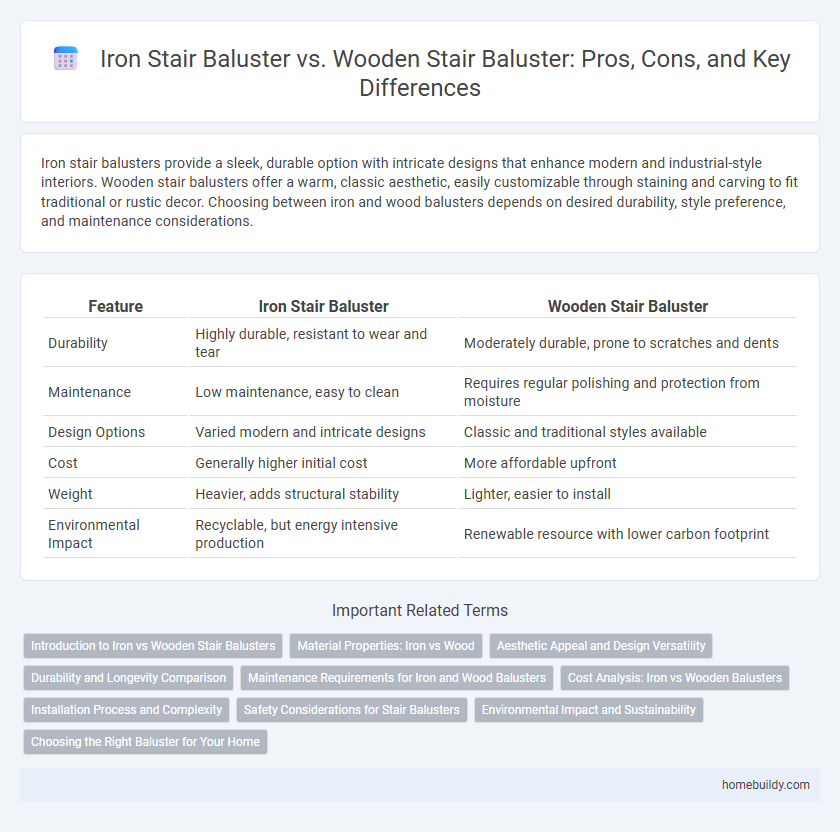Iron stair balusters provide a sleek, durable option with intricate designs that enhance modern and industrial-style interiors. Wooden stair balusters offer a warm, classic aesthetic, easily customizable through staining and carving to fit traditional or rustic decor. Choosing between iron and wood balusters depends on desired durability, style preference, and maintenance considerations.
Table of Comparison
| Feature | Iron Stair Baluster | Wooden Stair Baluster |
|---|---|---|
| Durability | Highly durable, resistant to wear and tear | Moderately durable, prone to scratches and dents |
| Maintenance | Low maintenance, easy to clean | Requires regular polishing and protection from moisture |
| Design Options | Varied modern and intricate designs | Classic and traditional styles available |
| Cost | Generally higher initial cost | More affordable upfront |
| Weight | Heavier, adds structural stability | Lighter, easier to install |
| Environmental Impact | Recyclable, but energy intensive production | Renewable resource with lower carbon footprint |
Introduction to Iron vs Wooden Stair Balusters
Iron stair balusters offer exceptional durability and intricate design possibilities, making them ideal for both modern and traditional staircases. Wooden stair balusters provide a warm, classic aesthetic and can be easily customized with various stains and carvings to match interior styles. Choosing between iron and wooden balusters depends on factors such as maintenance, strength, design preference, and overall architectural theme.
Material Properties: Iron vs Wood
Iron stair balusters offer superior strength, durability, and resistance to wear, making them ideal for high-traffic areas and outdoor use. Wooden stair balusters provide warmth, natural beauty, and ease of customization but require regular maintenance to prevent damage from moisture and pests. The choice between iron and wood depends on desired aesthetics, structural needs, and exposure conditions.
Aesthetic Appeal and Design Versatility
Iron stair balusters offer a sleek, modern aesthetic with intricate designs that enhance architectural details, providing high design versatility for various interior styles. Wooden stair balusters deliver a warm, classic charm that complements traditional and rustic decor but may have limited design complexity compared to iron. The choice between iron and wood balusters depends on the desired visual impact and flexibility in customization for staircase design.
Durability and Longevity Comparison
Iron stair balusters offer superior durability and longevity compared to wooden stair balusters due to their resistance to wear, moisture, and pests, making them ideal for both indoor and outdoor applications. While wooden balusters may require regular maintenance such as sealing or painting to prevent warping, cracking, and termite damage, iron balusters maintain structural integrity with minimal upkeep. The robust nature of iron ensures a longer lifespan and sustained aesthetic appeal, especially in high-traffic areas.
Maintenance Requirements for Iron and Wood Balusters
Iron stair balusters demand regular inspection for rust and corrosion, often requiring periodic cleaning, sanding, and repainting to maintain their durability and aesthetic appeal. Wooden stair balusters need frequent polishing, sealing, or varnishing to protect against moisture damage, warping, and insect infestations, especially in humid environments. Both materials benefit from consistent maintenance, but iron balusters typically necessitate less frequent upkeep compared to wood, which is more vulnerable to environmental changes.
Cost Analysis: Iron vs Wooden Balusters
Iron stair balusters typically cost between $40 and $150 per baluster, depending on design complexity and finish, while wooden balusters range from $10 to $60 each, offering a more budget-friendly option. The installation cost for iron balusters is generally higher due to their weight and the need for specialized tools, whereas wooden balusters are easier and faster to install, reducing labor expenses. Longevity and maintenance also impact overall cost; iron balusters require less frequent replacement but may need rust treatment, while wooden balusters can incur higher maintenance costs over time due to wear and potential damage.
Installation Process and Complexity
Iron stair balusters require precise measurements and often professional welding or drilling during installation, which increases complexity and time. Wooden stair balusters typically allow for easier cutting and nailing, making the installation process more straightforward and suitable for DIY projects. The choice between iron and wood influences not only aesthetic but also the skill level needed for proper and secure installation.
Safety Considerations for Stair Balusters
Iron stair balusters offer superior strength and durability, providing enhanced safety by minimizing the risk of breakage or bending under pressure. Wooden stair balusters, while aesthetically pleasing, may weaken over time due to wear, moisture, or insect damage, potentially compromising structural integrity. Selecting balusters that meet building codes for height and spacing is crucial to prevent falls and ensure maximum safety on staircases.
Environmental Impact and Sustainability
Iron stair balusters offer high durability and recyclability, making them a sustainable choice with a lower environmental footprint over their lifespan due to their long-term use and recyclability. Wooden stair balusters provide renewable sourcing and biodegradability, especially when sourced from certified sustainably managed forests, but may require more frequent replacement, impacting overall sustainability. Choosing between iron and wood involves balancing the energy-intensive production of iron with the renewable but potentially less durable nature of wood.
Choosing the Right Baluster for Your Home
Iron stair balusters offer exceptional durability, low maintenance, and a sleek, modern aesthetic that enhances contemporary home designs. Wooden stair balusters provide warmth, versatility in design, and the ability to be stained or painted to match various interior styles, making them ideal for traditional and rustic homes. Consider factors such as style preferences, maintenance requirements, and architectural compatibility when selecting between iron and wooden balusters to achieve the perfect balance of functionality and visual appeal.
Iron stair baluster vs Wooden stair baluster Infographic

 homebuildy.com
homebuildy.com